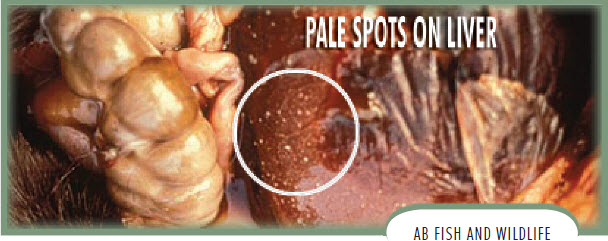Tularemia
| Question | Answer |
|---|
| Example |

|
| Can I still use the animal |
Yes - take safety precautions
|
| Commonly infected wildlife |
Ticks, Beavers, Muskrats, Hare Rabbits
|
| Is this animal infected |
- Affected animals may outwardly appear in good body condition, yet are sick or near death
- An enlarged liver or spleen is common
- Tiny pale spots and thin white strands of material may be seen on organs
|
| Can I get it |
Yes
- Bites or scratches from infected wildlife
- Contact with meat, water, feces, urine or body parts of infected animals
- Breathing in dust from pelts and paws
- Can penetrate intact skin
|
| How bad can it get |

Fever-like symptoms; early treatment reduces severity
|
| How can I protect myself and others |
- Take precautions, avoid tick bites!
- Wear long-sleeved clothing
- Use insect repellents
- Inspect yourself for, and remove, all ticks
- Handle animals found dead near human water sources with caution and report to The North Dakota Game and Fish Department
- When handling, dressing or skinning any wild animal:
- Wear disposable gloves
- Wash hands well afterward
- Cook beaver, hare and rabbit meat before eating it
|
| Symptoms in humans |
- Symptoms appear up to 14 days after infection:
- Fever, headache, chills, muscle pain
- Swollen, painful lymph nodes
- Ulcer at site of tick bite or animal contact
- Other symptoms can occur but are rare
- Seek medical attention - CAN BE FATAL
|
| Is it safe for pets |
Not Raw - Dogs and cats can die from tularemia
|
| What causes it |
- Bacteria called Francisella tularensis
|

